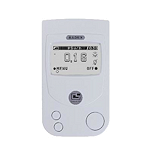The idea of documenting environmental fluctuations at alleged haunted locations dates back to at least the 1930's, when serious paranormal investigators like Harry Price began applying the principals of scientific method to spontaneous paranormal investigations in the field. Price standardized the practice of environmental monitoring during his famous investigation of Borley Rectory, and his methodologies proved so compelling they are still used in the field today.
 Harry Price and other notable paranormal researchers speculated that paranormal activity somehow affected the ambient environment, be it in the form of static electricity, humidity, temperature or background radiation. Price encouraged serious investigators to monitor the environmental conditions and establish baselines during their investigations, so that anomalous fluctuations could be observed and documented. Accumulating such data over a period of time could help identify patterns that might lead to possible explanations for paranormal activity. Unfortunately the technology of the early 20th century was not only unwieldy, it was cost prohibitive, so such information is extremely rare.
Harry Price and other notable paranormal researchers speculated that paranormal activity somehow affected the ambient environment, be it in the form of static electricity, humidity, temperature or background radiation. Price encouraged serious investigators to monitor the environmental conditions and establish baselines during their investigations, so that anomalous fluctuations could be observed and documented. Accumulating such data over a period of time could help identify patterns that might lead to possible explanations for paranormal activity. Unfortunately the technology of the early 20th century was not only unwieldy, it was cost prohibitive, so such information is extremely rare.
Paranormal investigators still subscribe to the theory that paranormal activity is associated with fluctuations of ambient environmental energy, but today these fluctuations can be measured with a variety of highly accurate and relativey inexpensive environmental monitoring devices. The most widely used monitoring devices include Electromagnetic Field (EMF) detectors, thermocouple thermometers, and infrared surface thermometers.
In order to use these tools effectively, it is important for paranormal investigators to understand the limitations of their equipment, because none of these devices were invented for paranormal research. Investigators not well versed in their intended use can be misled by “false” positives. Cynical skeptics may dismiss all alleged paranormal activity documented with corresponding environmental fluctuations as “false” positives, or natural environmental fluctuations caused by the unique geophysical properties of a particular location, but the growing archive of observations by credible paranormal researchers seems to indicate otherwise.
One of the most misunderstood tools in a paranormal investigator's toolbox is the EMF detector. Researchers widely believe that paranormal activity somehow influences or manipulates the environmental EMF in an allegedly haunted location, and it is these fluctuations that our EMF detectors pick up during investigations. This is a very simplistic view of the electromagnetic spectrum, and it is troubling that most investigators embrace this "theory" without question. EMF detectors have broad calibration ranges that overlap many common ambient sources of electromagnetic energy. Most display a sum of electomagnetic energy readings, while others can be set to pick up very narrow ranges of electromagnetic energy, allowing researchers to determine whether the source is radio frequency (RF), microwave or something else. These settings vary from model to model, so in order to fully understand what our EMF detectors are picking up, it’s important to have a basic understanding of the electromagnetic spectrum. The electromagnetic spectrum encompasses the range of all possible forms of electromagnetic radiation, from long radio waves through microwaves, infrared and visible light, ultraviolet light and ionizing radiation such as X-rays and gamma rays. Unless we employ tools that can detect energy fluctuations throughout the entire spectrum, we're missing the big picture; much like the three blind men examining an elephant struggled to identify what they were experiencing.
Elecromagnetic Spectrum (illustration by NASA)

Background radiation surrounds us all the time. It rises and falls with the pulse of the solar cycles and periodic fluctuations in the geophysical environment, and it varies from household to household based on the building materials and geological composition of the construction site. Granite counter tops and floor tiles can emit minute amounts of radon gas, and radon gas can accumulate in basements or other enclosed places. Radioactive scrap metals, antique radium clock dials and a variety of other unsuspected low level radiation sources may exist in a home or business.
A Geiger counter can detect these subtle changes in background radiation only if it’s calibrated to do so. The big clunky Cold War era models available online are useless for paranormal investigation, because they are not sensitive enough to detect minute changes in background radiation levels that could be related to possible paranormal activity. We use a Radex RD1503 made by Quarta; it is a simple digital dosimeter, which uses a low-voltage SBM20-1 type Geiger-Muller tube to detect beta and gamma radiation. It reads changes as small as .01 micro sieverts (0.01 μSv) per hour, and takes readings every ten seconds.
Through observation, experimentation and research we have determined a standard background radiation level (BRL) for southern California residential settings. We have documented normal “pulses” in the BRL, and compared the baseline readings to anomalous fluctuations that might coincide with possible paranormal phenomena. We use our Geiger counter in conjunction with an EMF detector, but we have observed that “hits” on one device do not necessarily coincide with “hits” on the other device. The most compelling observations to date have been significant drops in the baseline BRL that accompany a potentially paranormal event, such as an EVP capture or a documented personal experience.
Our research continues, and we learn more with each investigation. It is our hope that diligent documentation and field observations will yield tangible clues to the nature of paranormal phenomena.